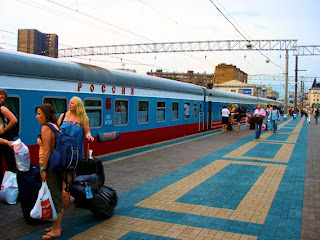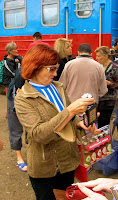A Trans-Siberian-Mongolian Journey
A long, long Railway Journey
Part
One
By
Gyan
C. A. Fernando
Introduction
The
Trans-Siberian Railway is considered the longest railway in the world. It was
built between 1891 and 1916 to connect Moscow with the Far-Eastern city of
Vladivostok. There are branch lines to China through Mongolia and Manchuria,
with a service continuing to North Korea. All are functional railways serving
the local population but there is some sort of a romance associated with it.
On
the 8th of August 2007, I traveled from Moscow to Irkutsk in
Siberia and then on the Trans-Mongolian to Ulaanbaatar and finally to Beijing.
The
Trans-Siberian proper goes from Moscow to the Pacific terminus of Vladivostok. The
Trans-Mongolian goes from Moscow to Beijing, China via Ulaanbaatar, Mongolia.
There
is also the Trans-Manchurian which travels through Siberia and Chinese
Manchuria to Beijing.
 |
| Moscow’s Yaroslavskij Station |
 |
| Moscow’s Yaroslavskij Station. Our group embarking |
Start of the journey
The
following account is based on my diary which I maintained throughout the
journey.
With
a group of fellow British travelers, we started off on the 7th of
August 2007 in the evening, from Moscow’s Yaroslavskij Station. On the advice
of our tour leader, we had purchased rye bread, salami, cheese and fruit. In my
case I also purchased a bottle of Vodka.
There
was a heavy thunderstorm that evening with localised flooding which delayed us
getting to the station. We made it in time and got into our second class
carriage. For this first leg from Moscow to Irkutsk I was to share a berth with
three “girls”; Catherine, our leader, Christine and Maggie.
Maintaining
a good speed, the train set off.
The
Train
The
train was the number 002, Moscow to Vladivostok The train was hauled by a
single electric locomotive with overhead current collection and ran on the
Russian gauge of 1,520 mm (4 ft 11 5⁄6 in).
The
first stop at Vladimir was after 210Km. The train ran on Moscow Time throughout
the journey whilst local time changed because of the time difference.
At
intermediate stops there was sufficient time to buy food and drink, including
vodka, from vendors on the platform.
At
most stops the water tanks in the carriages were filled, wheels were tapped and
brakes were checked. Often the locomotives (and loco crew) were changed.
Life
on the Train
After
the initial excitement we relaxed. Airline style hot food was served at
irregular intervals. We supplemented that with our own food.
A
wood fired boiler provided water for hot drinks and for pot noodle type food.
There were drinks parties complete with music in some compartments. Eventually, we got into our own routines: Some read books, other wrote their diaries. Some walked from one end of the train to the other. The stops were most welcome and gave us a chance to stretch our legs and take photographs.
(But
beware: The train can start off without warning and there are stories of
passengers getting stranded. The carriage attendant will tell you how long the
train stops and it is not a good idea to go too far away from the train.)
There were four bunks in each compartment the top ones being rather difficult to get into.
 |
| Drinks party |
 |
| Wood-fired boiler |
Unlike the loco crew, they travel the whole length of the line taking seven days each way. Some are couples and some are husband and wife.
(Continued: Part Two-The Journey Continues)
Copyright:
Gyan C. A. Fernando, 2012
Thanks to Catherine Dixon, wherever you are
Illustrations:

The photographs all belong to the author and are copyright.
More pictures available here: Picasa

The photographs all belong to the author and are copyright.
More pictures available here: Picasa
Further
Reading:
- The Trans-Siberian Railway (Wikipedia):http://en.wikipedia.org/wiki/Trans-Siberian_Railway
- The Practicalities (Wikitravel): http://wikitravel.org/en/Trans-Siberian_Railway
- The Trans-Siberian Route: http://www.waytorussia.net/TransSiberian/Route.html




No comments:
Post a Comment